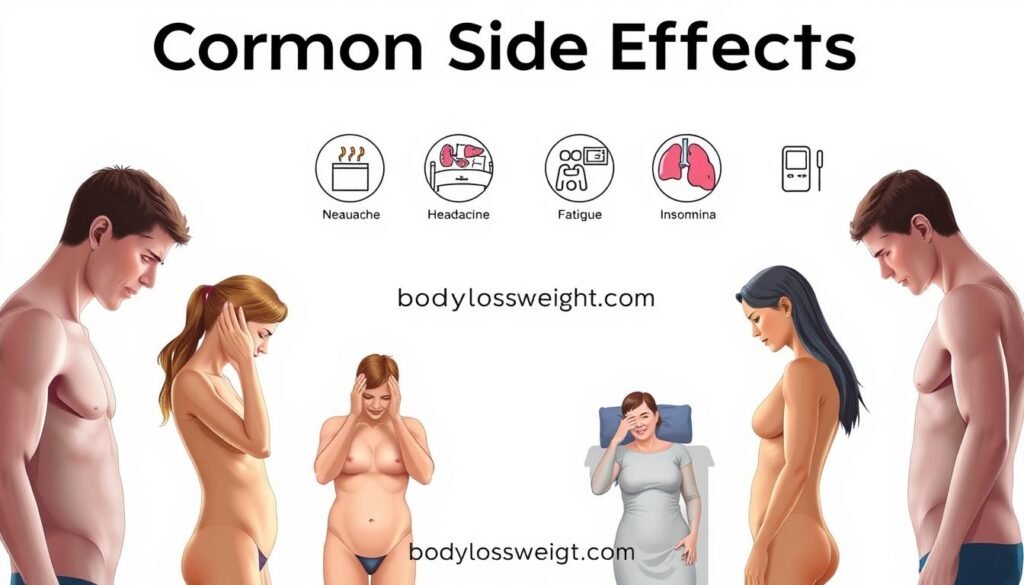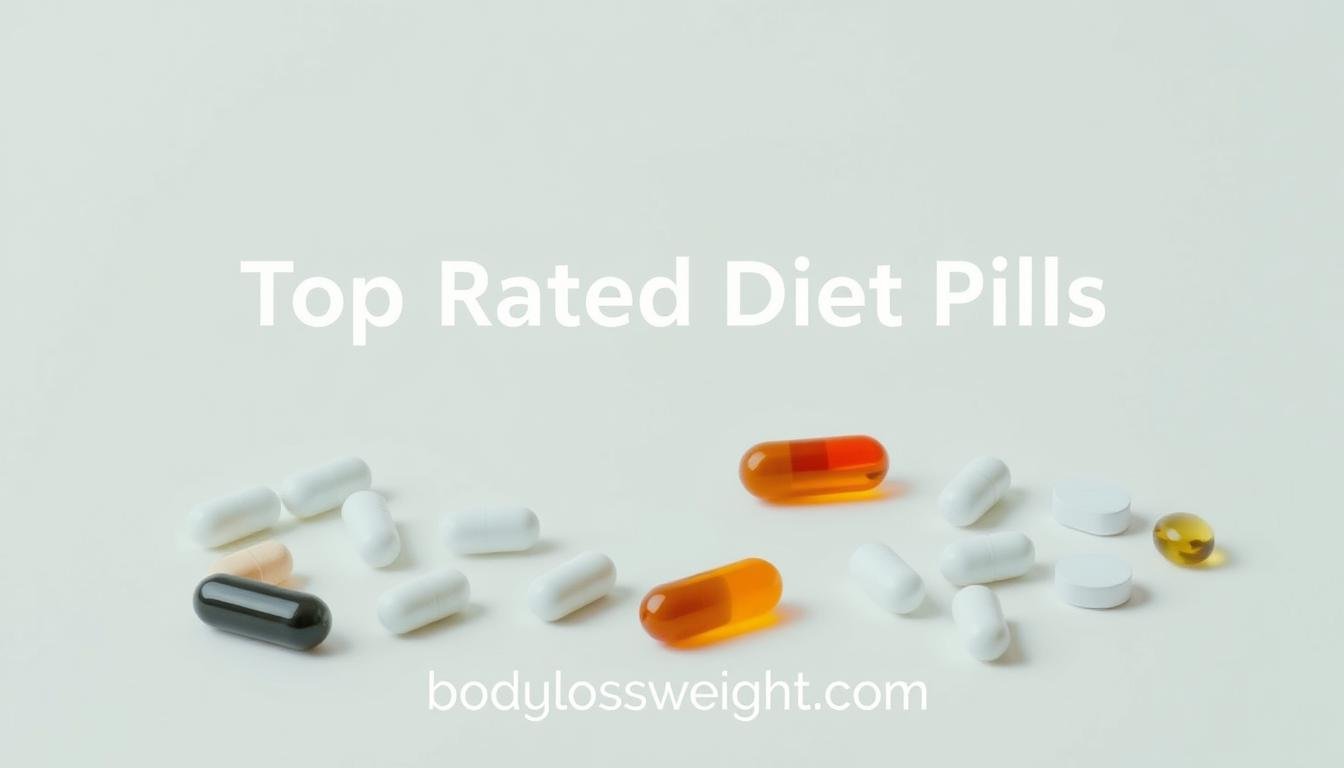Imagine starting the new year wanting to lose weight. Your friends talk about the best diet pills they found. They say these pills helped them start losing weight.
There are many weight loss pills and supplements now. They help people reach their fitness goals. But, these pills work best with healthy eating and exercise.
Thinking about trying these weight loss solutions is exciting. It could be part of your journey too.
Key Takeaways
- Best diet pills can aid in weight loss effectively.
- Top rated weight loss supplements are available on the market.
- Effective slimming pills work best alongside lifestyle changes.
- Combining medications with diet can enhance results.
- Understanding different weight loss options is crucial for success.
Understanding Weight Loss Medications
Weight loss medications help you on your way to a healthier weight. They are not for everyone. They are for those who can’t lose weight with diet and exercise alone. Your doctor will decide if you need them based on your health.
What Are Weight Loss Medications?
These medicines help you lose weight in different ways. Some make you feel less hungry. Others change how your body uses nutrients. Knowing how they work helps you choose the right one for you.
Types of Weight Loss Medications Available
There are many types of weight loss medicines. Here are a few:
- Lipase Inhibitors: Orlistat (Xenical and Alli) stops fat from being absorbed in your intestines.
- GLP-1 Receptor Agonists: Drugs like semaglutide (Wegovy) and liraglutide (Saxenda) control hunger and make you feel full.
- Combination Medications: Naltrexone-bupropion (Contrave) and phentermine-topiramate (Qsymia) work on hunger and metabolism to help you lose weight.
Best Diet Pills for Fast Results
Fast-acting diet pills are great for starting your weight loss journey. Many people choose these pills for quick results. They work by reducing hunger and boosting metabolism, leading to fast weight loss.
But, how much weight you lose depends on your health, diet, and exercise. Everyone’s body is different.
Overview of Fast-Acting Diet Pills
Looking at popular fat burners, ingredients are key. Caffeine and green tea extract help burn fat. They give you more energy and help use fat for energy.
How They Work to Promote Weight Loss
Top slimming pills include GLP-1 receptor agonists. They make you feel full and help control hunger. Knowing how these pills work helps you choose wisely.
For the best results, use these pills with a healthy diet and exercise. This way, you’ll lose weight faster and better.
Clinically Proven Appetite Suppressants
Appetite suppressants can help you manage your weight. They work by changing how your brain and body feel hunger. This can make you feel full and eat less, helping you lose weight.
How Appetite Suppressants Function
These medicines change brain chemicals. They affect serotonin and norepinephrine, which help you feel full. They can also reduce cravings and help you eat less.
Top Choices in Prescription Appetite Suppressants
Many prescription drugs help control appetite:
| Medication | Features | Administration | Expected Results |
|---|---|---|---|
| Liraglutide (Saxenda) | Daily injections; enhances fullness | Injection | Significant weight loss with lifestyle changes |
| Naltrexone-Bupropion (Contrave) | Combination of an opioid antagonist and an antidepressant; reduces cravings | Oral tablet | Improvement in weight management |
| Semaglutide (Wegovy) | Effective for metabolic health; appetite suppression | Injection | Notable weight loss in studies |
Using these medicines can help you reach your weight loss goals. Always talk to a doctor before starting any new medicine. They can help find the best one for you.
Popular Fat Burners in the Market
Fat burners help many people lose weight. They use fat burning supplements to boost your metabolism and energy. They also help burn fat. These products often have caffeine and green tea extract.
What Are Fat Burners?
Fat burners are a mix of ingredients to help lose body fat. They can speed up your metabolism and control hunger. They use natural parts that work together to help you lose weight.
Most Effective Fat Burners Reviewed
Many weight loss supplements are known for helping lose fat. Here are some:
- Caffeine: It boosts energy and helps your metabolism.
- Green Tea Extract: It has catechins that help burn fat, especially when you exercise.
- Conjugated Linoleic Acid (CLA): It may improve your body shape by reducing fat.
- Forskolin: It comes from the Coleus forskohlii plant. It’s thought to help lose fat by breaking it down.
When picking fat burners, check their safety. Many fat burning supplements aren’t FDA approved. It’s important to do your research and talk to a doctor if needed.
Natural Diet Pills: A Safe Alternative
Choosing natural diet pills can make losing weight safer and healthier. These supplements use plant-based ingredients. They are less likely to cause bad side effects.
Products like Garcinia Cambogia, Green Coffee Bean Extract, and Raspberry Ketones are popular. They help improve how your body burns fat and control hunger.
Benefits of Using Natural Supplements
Natural supplements have many good points for weight management. Some key benefits include:
- Fewer side effects compared to synthetic alternatives.
- Supports healthy metabolism and increases energy levels.
- Helps control appetite naturally, making it easier to stick to your diet.
Top Natural Diet Pills on the Market
Many safe diet pills are popular for their results:
- Garcinia Cambogia: Known for its potential to suppress appetite and inhibit fat production.
- Green Coffee Bean Extract: Rich in antioxidants, it may help boost metabolism.
- Raspberry Ketones: Often used for their supposed fat-burning properties.
- Glucomannan: A natural fiber that helps you feel fuller for longer, aiding in weight loss.
Understanding Weight Loss Medication Side Effects
Weight loss medications can help you reach your goals. But knowing the side effects is key. Each drug has its own side effects and risks.
Understanding these helps you manage side effects better. It makes your weight loss journey safer.
Common Side Effects of Prescription Diet Pills
Many medications share common side effects. You might feel nausea, constipation, diarrhea, headaches, or even vomit. These side effects can go away with time.
But knowing the risks of each drug is important. For example, Bupropion-naltrexone might cause headaches and high blood pressure. Liraglutide can lead to nausea and vomiting.
| Medication | Common Side Effects | Serious Side Effects |
|---|---|---|
| Bupropion-naltrexone | Nausea, headache, constipation | Increased blood pressure |
| Liraglutide | Nausea, vomiting | Possibility of pancreatitis |
| Orlistat | Gas, loose stools | Severe liver injury (rare) |
| Phentermine-topiramate | Increased heart rate, insomnia | Risk of birth defects |
| Semaglutide | Nausea, vomiting, diarrhea | Potential thyroid tumors |
| Setmelanotide | Swollen skin, nausea | Depression, suicidal thoughts |
Managing Side Effects When Taking Medications
Talking to your doctor about side effects is important. They can adjust your dosage or suggest diet changes. They might also give you more medications.
Going for regular check-ups is key. This way, you can handle risks and watch for severe side effects. With the right care, you can lose weight safely and healthily. For more tips, check out this guide on weight loss drugs.

The Best Metabolism Boosters for Weight Loss
Metabolism boosters are important for losing weight. They help you burn more calories. This makes it easier to manage your weight.
Many people look for the best metabolism boosters. They want to boost their metabolism and reach their fitness goals. Common boosters include caffeine, green tea extract, and protein-based products.
What Are Metabolism Boosters?
Metabolism boosters speed up your body’s metabolic processes. This means you burn more calories all day. Many top products have natural ingredients that help.
Caffeine is known to increase energy and burn fat. It’s a popular choice for weight loss.
Top Rated Supplements for Metabolism Enhancement
Caffeine is a top choice for boosting metabolism. It helps burn more calories. Green tea extract also works well, helping with fat oxidation and metabolism.
Conjugated linoleic acid (CLA) might improve metabolic rates too. It’s important to research before choosing a booster. This ensures you pick safe and effective options. For more info, check out this comprehensive guide.
Long-term vs Short-term Use of Diet Pills
It’s important to know when to use short-term diet pills versus long-term weight loss medications. Both types have different uses. They can greatly help in keeping weight off.
When to Use Short-term Diet Pills
Short-term diet pills are good for quick weight loss. They are for people who need to lose weight fast for health reasons or special events. These pills are usually used for up to 12 weeks.
They work best when you also make healthy lifestyle changes. Like eating better and exercising more. But, be careful of side effects and the chance of becoming too dependent.
Understanding the Need for Long-term Medication
Long-term weight loss medications are for people with chronic obesity. They help control hunger and boost metabolism. This way, you can keep your weight in check over time.
Medicines like semaglutide and liraglutide are made for long-term use. It’s key to see your doctor regularly. This makes sure your weight loss plan fits your ongoing needs and lifestyle.

| Type of Medication | Duration of Use | Purpose |
|---|---|---|
| Short-term Diet Pills | Up to 12 weeks | Rapid weight loss for specific situations |
| Long-term Weight Loss Medications | Ongoing | Sustaining weight loss and managing chronic obesity |
Choosing between these options depends on your goals and health. Always talk to a doctor to find the best plan for you.
Conclusion
Understanding weight loss medications and diet pills is key. It helps you make choices that fit your health goals. You might choose fast-acting pills, natural supplements, or long-term medications.
It’s important to use these pills with a balanced diet and exercise. This mix is crucial for lasting weight loss.
When thinking about losing weight, talk to doctors first. They can give advice based on your health. This helps you find the best plan for you.
Looking at weight loss in a big picture way is smart. Choosing the right pills and strategies makes your journey better. It turns weight loss into a rewarding path.
FAQ
What are the best diet pills for weight loss?
The best diet pills depend on your goals and needs. Orlistat (Xenical, Alli) and GLP-1 receptor agonists like semaglutide (Wegovy) are top choices. Garcinia Cambogia is also popular. Always talk to your doctor first.
How do appetite suppressants work?
Appetite suppressants change how your brain handles hunger. They make you feel full or less hungry. This can help you eat fewer calories and lose weight.
Are natural diet pills effective?
Yes, natural diet pills can help with weight management. Green Coffee Bean Extract and Glucomannan are good for appetite control. But, make sure to choose products that are tested for quality and safety.
What are some common side effects of weight loss medications?
Weight loss meds can cause stomach problems like nausea and diarrhea. They might also lead to headaches or trouble sleeping. Always tell your doctor if you have any side effects.
How do metabolism boosters aid in weight loss?
Metabolism boosters increase how fast your body burns calories. Caffeine and green tea extract are popular for this. They help burn fat and support weight loss.
Can fast-acting diet pills deliver quick results?
Yes, fast-acting diet pills can give quick results. They work by controlling hunger and boosting metabolism. But, they work best when used with diet and exercise.
Is it safe to use fat burners?
Fat burners can be safe if used right and chosen wisely. Always check the safety of ingredients and talk to a doctor. Some fat burners aren’t regulated by the FDA.
What should I consider before using diet pills?
Think about your health, weight loss goals, and any meds you take before using diet pills. Talking to a doctor is key to choosing the right and safest option for you.
How do I know if a diet pill is clinically proven?
Look for diet pills with clinical trials and FDA approval. These have solid evidence of working. Also, check if the ingredients and research are transparent.
